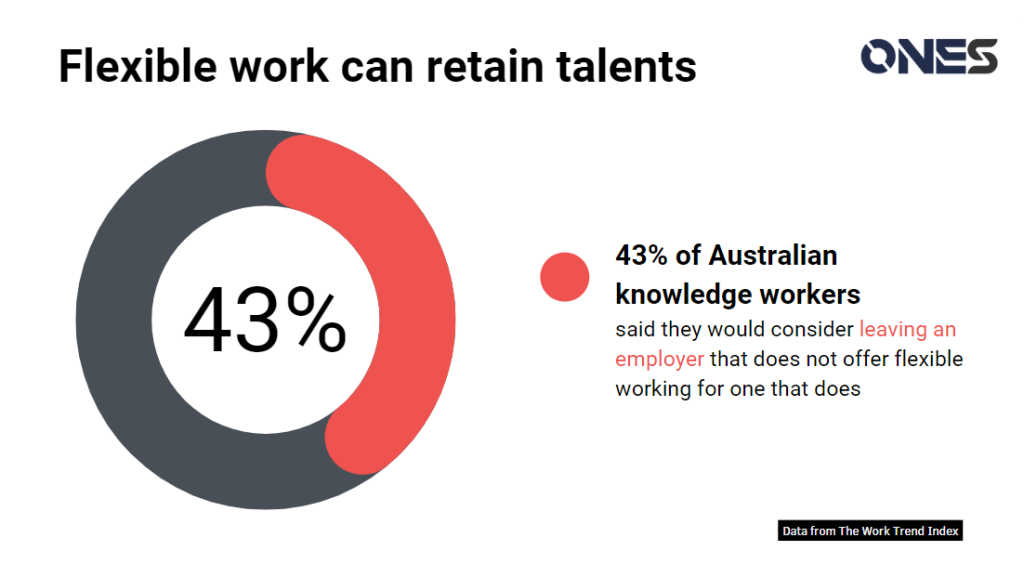Business leaders must recognize that how, when, and where we work are no longer constrained by traditional notions of time and space.
After the epidemic, companies around the world are popularly implementing hybrid work and this will remain to become a new norm.
Table of Contents
What is Hybrid work?

Hybrid work is an approach that takes into account the individual’s needs, whether they’re at home or at the office. Our platform enables people to work from any location, and move between sites as needed.
Many organizations see hybrid work as the evolution of remote working, allowing employers to better integrate remote working into overall business processes while providing comparable work experience for remote workers.
As Australia plans for the post-COVID19 era, a renewed focus has been placed on the future of work. Moreover, Australia had an above-average level of working from home in 2020 (47%). (Tesltra)
Hybrid work trends in Australia

Before Covid 19 started, 57% of workers preferred the traditional way of working – working in an office. During the epidemic, since workers were not able to return to the office, 35.4% of workers said that they became accustomed to working from home.
Today, a survey reported that 37.8% of workers prefer to work flexibly to achieve a balance between life and work. (Swinburne University of Technology Report)
Hybrid working in an Australian state or territory

A report by Telstra finds that businesses adopting a hybrid model are 28% more likely to deliver new and innovative products or services to the market.
Also, some factors cause the Australian state or territory’s adoption of hybrid working, such as the company policies or recommendations of the Government.
The Government lockdowns in Victoria likely drove the state’s high adoption rate. During COVID-19, the biggest increases in hybrid working have occurred in the Australian Capital Territory (ACT), Victoria, and New South Wales (NSW). (Telstra)
The potential economic impact of hybrid work in Australia

Hybrid working reduces long-entrenched barriers to employees, such as the problem of the distance between the workplace and home, long work hours, and high travel expenses.
By estimation, hybrid work can attract 53,500 extra people to enter the labor force in the future, and then the workforce has the potential to deliver significant economic benefits to Australia, increasing national Gross Domestic Product (GDP) by $18.3 billion and creating additional 42,500 full-time jobs by 2030-31. (Telstra)
Flexible work can retain talents

Talent is an important resource for companies. During the epidemic, the epidemic of remote work has caused a high global brain drain.
43% of Australian knowledge workers said they would consider leaving an employer that does not offer flexible working for one that does, rising to 46% in Sydney and Melbourne. (Swinburne University of Technology Report)
Australia’s Gen Z is the main workforce
In Australia, Gen Z workers prefer flexible working (46%) twice as much as Baby Boomers (23%). There are around three-fifths of the knowledge workforce made up of Millennials and Gen Z workers, therefore generational change will lock in a flexible working future to their needs.
(Swinburne University of Technology Report)
The needs of Australia’s Gen Z

According to Gen Z workers, the leading reasons they want to return to the office are to avoid distractions at home (e.g., roommates), for their mental health and well-being and to maintain relationships with colleagues, and to feel included. They would prefer to work in the office for 3 days each week.
In the other working time (around 2 days), they would like to work remotely. (Swinburne University of Technology Report)
The impact of implementing hybrid working on Australia Businesses
Hybrid Working Impact on Quality

Since implementing hybrid working, the quality of work has improved and impacted the following industries: (Telstra)
- 66% of businesses are in technology and media;
- 63% in banking, finance, and insurance; and
- 29% in retail.
Hybrid Working Impact on Creativity

52% of businesses in mining, energy, and resources and 50% in technology have increased creativity since implementing hybrid working. The reasons are the following like these:
1. Hybrid working increases the opportunities to collaborate, co-design, and engage in cross-functional teaming. (Telstra)
2. Hybrid working can lead to greater team diversity, work styles, ways of collaborating and generating ideas –all of which can drive creativity. (Telstra)
Trade-off for Businesses not offering remote work and hybrid work

If the employers do not offer flexible working to the employees, most of the workers expect a pay rise as their leading trade-off.
Another top two and three reasons for respondents are they want more leave or time off and better job security.
In the survey, 13% of respondents said flexible working is non-negotiable, and that could make many employees a flight risk in search of roles that are flexible.
Only 15% of workers said they didn’t need to convince them to stay.
(Swinburne University of Technology Report)
Reasons why Australians choose against work in the office

The costs of the commute are the top reason why Australians don’t want to work in the office.
However, the main issue is they don’t want to lose the flexible working hours which are the common factor of second and third reasons. Loss of flexibility at work could not protect their work-life balance.
(Swinburne University of Technology Report)
Reasons why Australians choose to work at office/client location

The top reason many workers want to work in the office is they think that the office is better to set up for work.
For example, some department workers need to have face-to-face meetings with the clients, therefore they need meeting rooms to serve the clients. The top second and third reasons are collaboration in person and relationships with colleagues.
These three top reasons show that the goal of working in the office is for employees to want to connect with others. (Swinburne University of Technology Report)
What would you need to work in the hybrid office?

ONES is one of the famous all-in-one smart office systems that can help you to easily implement hybrid working at ease. You can easily perform virtual meetings, desk-hoteling, and digital office management with our Room Booking, Desk Booking, and Visitor Management features.
You can also explore our leaflet to understand more of our features: https://ones.software/assets/booking/main/2022_ONES_leaflet_v1.pdf
Contact us: hello@ones.software, or visit ONES Software official website for more information: https://ones.software/.


